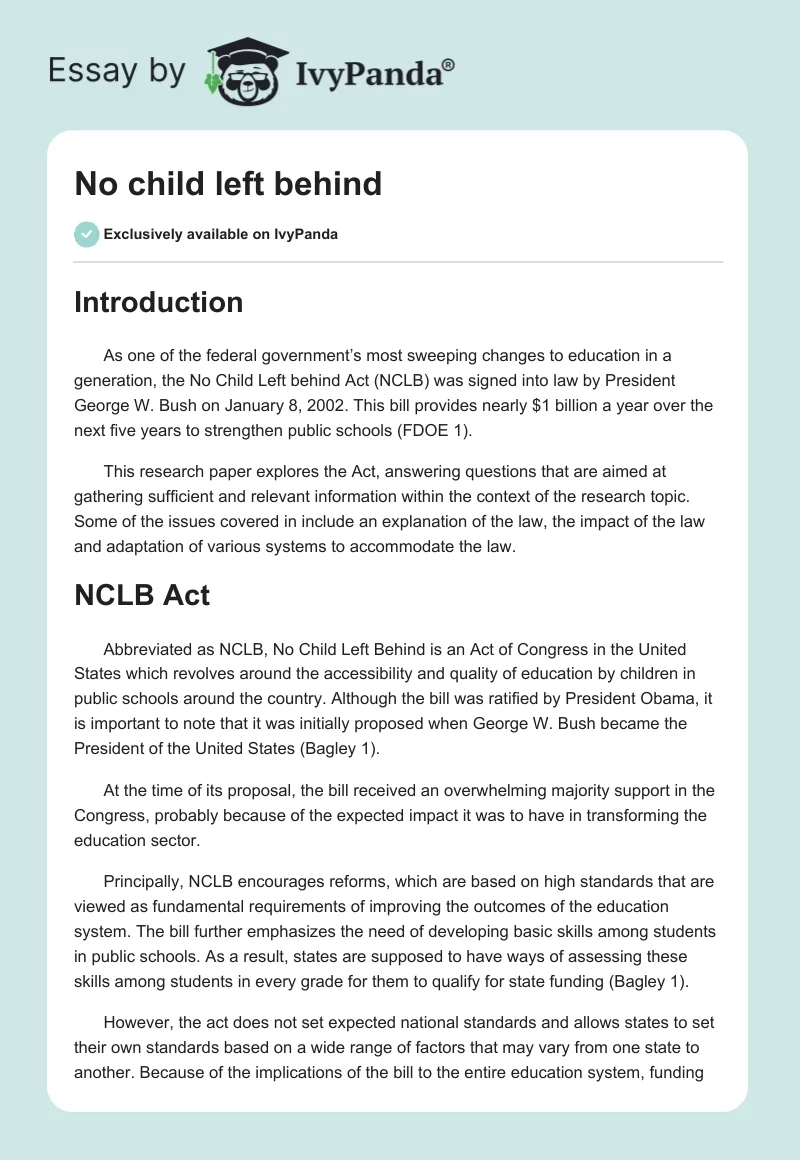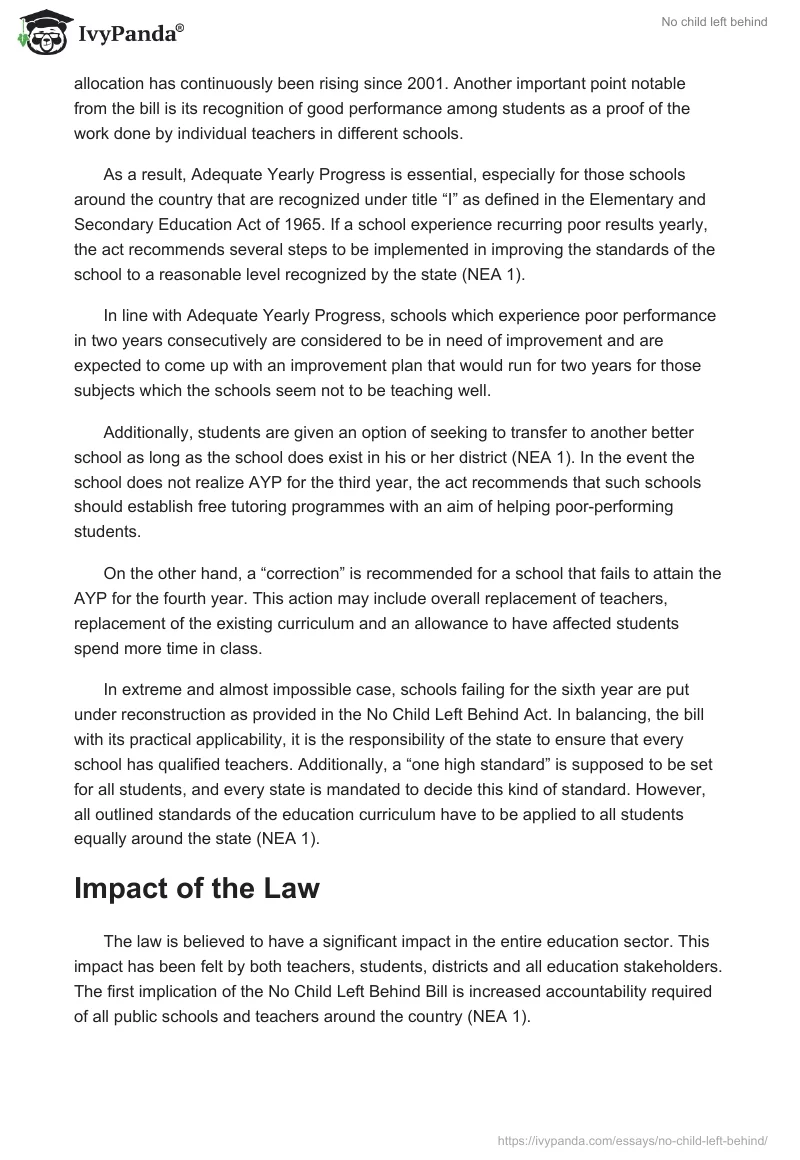Introduction
As one of the federal government’s most sweeping changes to education in a generation, the No Child Left behind Act (NCLB) was signed into law by President George W. Bush on January 8, 2002. This bill provides nearly $1 billion a year over the next five years to strengthen public schools (FDOE 1).
This research paper explores the Act, answering questions that are aimed at gathering sufficient and relevant information within the context of the research topic. Some of the issues covered in include an explanation of the law, the impact of the law and adaptation of various systems to accommodate the law.
NCLB Act
Abbreviated as NCLB, No Child Left Behind is an Act of Congress in the United States which revolves around the accessibility and quality of education by children in public schools around the country. Although the bill was ratified by President Obama, it is important to note that it was initially proposed when George W. Bush became the President of the United States (Bagley 1).
At the time of its proposal, the bill received an overwhelming majority support in the Congress, probably because of the expected impact it was to have in transforming the education sector.
Principally, NCLB encourages reforms, which are based on high standards that are viewed as fundamental requirements of improving the outcomes of the education system. The bill further emphasizes the need of developing basic skills among students in public schools. As a result, states are supposed to have ways of assessing these skills among students in every grade for them to qualify for state funding (Bagley 1).
However, the act does not set expected national standards and allows states to set their own standards based on a wide range of factors that may vary from one state to another. Because of the implications of the bill to the entire education system, funding allocation has continuously been rising since 2001. Another important point notable from the bill is its recognition of good performance among students as a proof of the work done by individual teachers in different schools.
As a result, Adequate Yearly Progress is essential, especially for those schools around the country that are recognized under title “I” as defined in the Elementary and Secondary Education Act of 1965. If a school experience recurring poor results yearly, the act recommends several steps to be implemented in improving the standards of the school to a reasonable level recognized by the state (NEA 1).
In line with Adequate Yearly Progress, schools which experience poor performance in two years consecutively are considered to be in need of improvement and are expected to come up with an improvement plan that would run for two years for those subjects which the schools seem not to be teaching well.
Additionally, students are given an option of seeking to transfer to another better school as long as the school does exist in his or her district (NEA 1). In the event the school does not realize AYP for the third year, the act recommends that such schools should establish free tutoring programmes with an aim of helping poor-performing students.
On the other hand, a “correction” is recommended for a school that fails to attain the AYP for the fourth year. This action may include overall replacement of teachers, replacement of the existing curriculum and an allowance to have affected students spend more time in class.
In extreme and almost impossible case, schools failing for the sixth year are put under reconstruction as provided in the No Child Left Behind Act. In balancing, the bill with its practical applicability, it is the responsibility of the state to ensure that every school has qualified teachers. Additionally, a “one high standard” is supposed to be set for all students, and every state is mandated to decide this kind of standard. However, all outlined standards of the education curriculum have to be applied to all students equally around the state (NEA 1).
Impact of the Law
The law is believed to have a significant impact in the entire education sector. This impact has been felt by both teachers, students, districts and all education stakeholders. The first implication of the No Child Left Behind Bill is increased accountability required of all public schools and teachers around the country (NEA 1).
According to the bill, every school must show quantifiable improvement in the performance of students in order to prove its efforts throughout every fiscal year. This is accompanied by measures discussed above that mainly affect non-performing schools and teachers (U.S. Department of Education 1).
The law further supports reduction of funding in cases where schools do not show any performance progress. The main purpose of this action is to enable teachers and all stakeholders to understand the immense significance of the education system to the nation (U.S. Department of Education 1).
Additionally, the law makes it possible to have a link between students’ standards and state academic content. Furthermore, it insists that all schools should establish measuring mechanisms in order to tell the performance of students at every grade starting from the third up to the eighth (U.S. Department of Education 1).
Beyond this stage of learning, the performance of students in high schools has to be determined at least once. Another impact is that it allows access of academic information of students by their parents through issuance of report cards. These report cards clearly indicate the Adequate Yearly Performance to enable parents to understand the progress of their sons and daughters. In addition, the school is obligated to disclose the professional level of the teacher to the parent to win the confidence of parents.
Besides having set standards for schools and teachers around the country, the bill also impacts students in various ways. Unlike in cases where schools denied students opportunities to transfer to another school within the district, the No Child Left Behind bill allows bright students in schools that are unable to meet the Adequate Yearly Progress to transfer to better ones within the district (Bagley 1).
Otherwise, schools are supposed to execute performance strategies like free tutoring and increased time, especially for those students who have weak performance standards.
Conclusion
No Child Education Bill is one of the most praised bills that promise to transform the American education system and make it performance-oriented. By insisting on performance standards, the government acknowledges the need to link resources and performance. In other words, its funding of the public education system has to be reflected through good performance from students through the efforts of schools and teachers.
By holding schools and teachers accountable for the performance of students, the law echoes the role of a teacher that goes beyond class work teaching. However, in its continuous implementation, performance measuring parameters have to remain harmonized to promote fair gauging of students’ performance across states.
Works Cited
Bagley, Jennifer. “No Child Left Behind.” Education Week. 2004. Web.
FDOE. “No Child Left Behind Act.” Florida Department of Education, 2005. Web.
NEA. “No Child Left Behind Act (NCLB).” National Education Association, 2011. Web.
U.S. Department of Education. “Elementary and Secondary Education Act.” U.S. Department of Education, 2011. Web.


